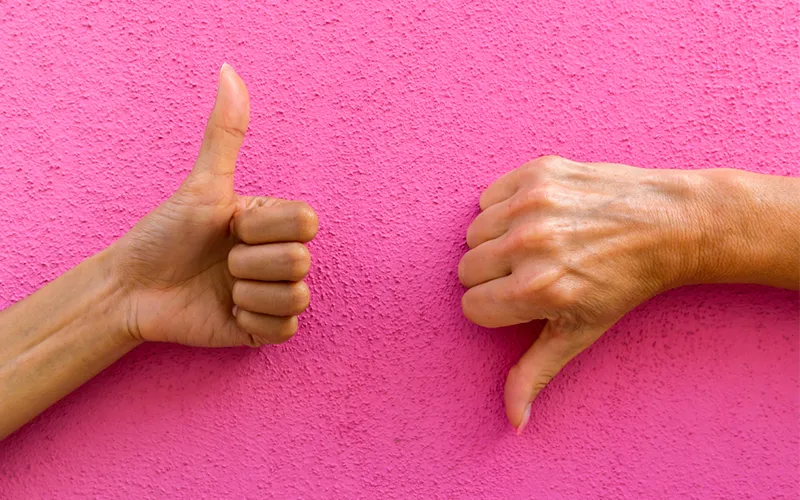


Giving likes the thumbs down

If you found this blog via one of Pull’s social media channels, underneath the post you will have (hopefully) seen a handful of likes. Whether they’re represented by the laidback, nonchalant cool of a Fonzie-style thumbs up, as on Facebook, LinkedIn and YouTube, or the rather more forward and emotive heart favoured by Instagram and Twitter, it is fair to argue that the ‘like’ has been one of the most revolutionary creations of the past ten years.
But it now finds itself under threat.
Back in May, Instagram Canada began running a trial where like counts on posts were hidden within users’ feeds. The idea being that the quality of the image, the way it made you feel and whatever emotions it stirred up should be enough for you to engage with it. Not whether it had enough likes that you deemed it worthy of your attentions.
And there’s the other side of the coin to consider. If we’re honest, every one of us shares content on Instagram because we want people to check out our image. To validate us with a ‘like’. Sure, some of us care more than others, but you can’t argue with science – the sweet dopamine hit we get from a like on our posts has been likened to the same thrill that keeps gamblers at the table (or even sex). But what if those likes aren’t forthcoming? What effect does that have on our wellbeing? This focus on mental health is partly what’s driving these changes.
It’s been a tough few years for a lot of the social platforms. Whether it’s Facebook’s misuse of data, Twitter’s inability to deal with abusive accounts or the rise of extreme content on YouTube, the platforms have found themselves under increasing scrutiny. So, the big social networks are doing what they can to win back consumer trust. Putting the users – and their mental wellbeing - back at the centre of the platforms and what they do is a smart move. It shows that these digital behemoths still care (if that sounds slightly cynical, forgive me - although all those platforms remain free to use, meaning it’s the advertisers who really remain at the centre).
And maybe giving the thumbs up a thumbs down isn’t a bad thing, just a sign of the times. According to Gen Z: Exile on Mainstream, a report created by the IPA, users aged 16-23 couldn’t care less about chasing likes, ranking gaining a “high number of likes” as one of their least important cultural drivers (perhaps it’s no coincidence that the same study found mental well-being to be the second-most important). This also means they’re less likely to hit the ‘like’ button themselves. Where does this leave the platforms and your brand’s social strategy then?
Well, unsurprisingly, it all comes down to authenticity again. You see, it’s not just ‘likes’ that Gen Z are kicking against. It’s your entire social feed as you know it. That beautifully crafted shot of your smashed avo? Not arsed. Hitting that yoga pose on the beach? Next. They’re not interested. This has led to some hailing the death of the ‘Instagram Aesthetic’. Out with your DSLR, in with your camera phone. For Gen Z, the Insta caption is almost more important than the image.
This quest for authenticity and rawness also goes a long way to explaining the rise of Stories. Steven Bartlett, founder of The Social Chain, contends that these are the natural successor to status updates (remember when you used to do those). Raw, easily digested and disposable. And of course, these don’t come with such an obvious and easy ‘like’ mechanism. It’s all about short, engaging content.
If the social networks give less and less prominence to likes, what does that mean for your content and the approach your brand takes towards these platforms moving forwards?
You’ll need to craft a social strategy that begins to focus on other engagement measures. Part of the ‘like’ button’s success has been just how easy it was to do. It has become quite a passive act. I think we’re all guilty of hitting ‘like’ on social posts based purely on the headline, without even bothering to read the article. Take away the like functionality and how can I show that yes, I like this content and agree with it? Well, first of all I’ll probably have to read beyond the headline. Then, if I still like it, perhaps I’ll end up sharing it because that’s now the only way my friends and followers will know that I like and agreed with or enjoyed this content.
Suddenly, the reach of the post has grown (I mean, not by much, I don’t have that many followers), CTRs have improved and – in the case of, say, blog posts and articles – time spent on your site has increased. It might sound obvious or overly simplistic, but your content game needs to be strong. The removal of likes could also impact the algorithm’s these platforms use to serve up content. If nobody is able to ‘like’ your content, then you’re going to need to make sure it’s of the requisite quality that they’re going to want to read it.
To loop back around to stories, these are a great indicator of where content might be heading and where you’ll now find your best engagement. Consider all the interactivity, from polls and quizzes to gamification that stories offer, and suddenly, your audience, followers and fans are now truly active participants. A like is one thing, but someone taking the time to send in a question or participate in a poll? That’s another level of engagement right there. If your brand hasn’t already done so, getting to grips with these features is going to be key to your performance on social over the coming years.
The best brands are already great at sparking conversation, debate, interaction and engagement, but this would need to take on greater prominence. And it’s something the platforms are trying to encourage. As well as the Instagram trial our Canadian friends have been exposed to, Twitter have been testing a version of the platform where likes and RTs are hidden, to try and focus on generating actual conversations amongst users and the brands the follow.
Of course, I’m writing this in the week that Facebook has announced its new crypto-currency, Libra. WeChat has already had huge success pivoting form a social network to ‘an app for everything’, and perhaps that’s where these other social networks will eventually end up, and to hell with content. For now however, the key takeaway, as it always has been, is to keep producing great, engaging content. Easy, right?
Posted 1 July 2019 by Ben Waterhouse